A chromosome walk Teach article
Stroll through biological databases: Walking on chromosomes is a CusMiBio project that teaches students how to explore biological databases and extract basic information about human genes. It is a collaborative activity based on working together and sharing discoveries.
With the complete sequence of the human genome, for the first time, the number of genes and their location is known. Scientists are, therefore, able to draw a very precise map of our genetic ‘instruction booklet’. Genes are just one of the signs shown on this map. They are fundamental, since they contain the DNA sequences that carry the information necessary to direct the biological functions of our body. Genes are subject to a great deal of research and an immense amount of data is produced every day in scientific laboratories and sorted into huge databases.[1–8] All the information is organized in an integrated way and is freely accessible to everyone. However, there is so much data and the organization is rather complex, so anyone who is not a specialist may struggle to find the information they are interested in.
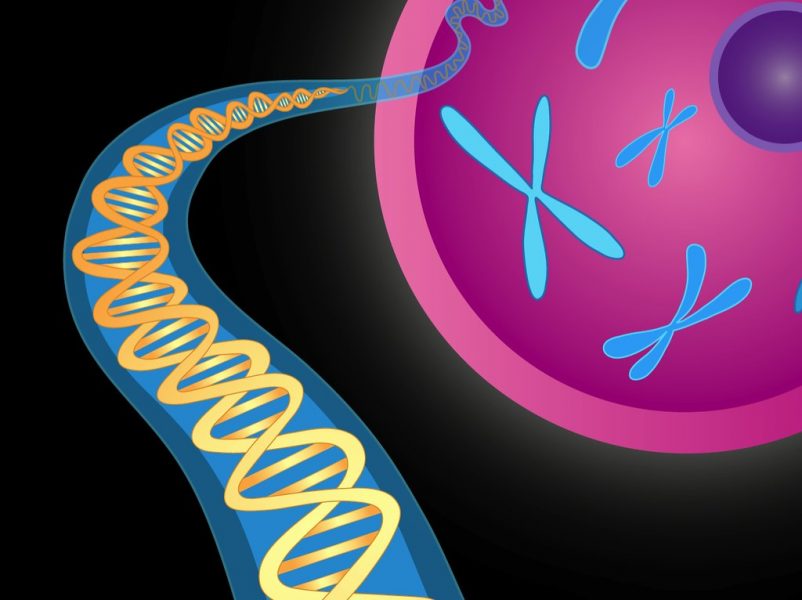
This set of activities offers a guided visit through the main databases of genes and proteins. Students are guided through collecting relevant data regarding a gene of choice in a given chromosomal location to construct a sort of identity (ID) card of this gene. It is aimed at students aged 14–19 and assumes prior knowledge of the human genome, Mendel’s laws of heredity and basic genetics concepts, DNA mutations and phenotypes, and the structure and function of proteins.
Skills developed and learning objectives:
- teamwork and collaborative working
- problem solving and critical thinking
- working autonomously and taking responsibility
- using clear and informative scientific language
- awareness of the importance of genomics
- better understanding of the basis of genetic diseases
- use of bioinformatic databases for scientific research
The activities can be carried out in isolation, but by joining the Chromosome Walking project from CusMiBio, teachers and students can join an ‘authentic’ collaborative research project based on the exploration of genomic databases and share their results with other schools. In this case, the following timeline is suggested:
Sep–Dec: Learn and practice
Students try various activities to familiarize themselves with accessing the databases and finding information.
Jan–Mar: Creative phase
Teams choose their gene of interest and build up a gene card for it.
Apr–May: Submissions and exhibition
Gene cards are reviewed and then submitted to CusMiBio. Posters can also be printed to display the school’s contribution to the project.
Phase 1: Learn and practice
In this phase, the students learn a bit more about the basic concepts and genomic databases. It will take about 2–4 lessons, depending on how much time is allowed for each exploration step. You can skip to step 5 if all the scientific concepts in the previous steps have already been covered in class.
Materials
- Tablets or PCs with internet access
- The Genetics Science Learning Centre website
- The human chromosome map on the National Center for Biotechnology Information (NCBI) website[1]
- The information archive of the Human Genome Project[2]
Procedure
- Watch videos for the ‘Tour of basic genetics’ on the Genetics Science Learning Centre website.
- Divide students into groups of 4–5.
- Assign each group a video and have them formulate four questions with multiple-choice answers. Each group should present their questions to classmates with a free game-based learning platform like Kahoot; in this way, students can improve their knowledge by means of an engaging learning activity.
- Encourage the students to try out and explore some of the other activities/info pages on this site. Students can pick what most interests them, or teachers can assign a few to each group.
- Take a look at some simplified human genome maps as a first, ‘soft’ approach to genomic data.
- Look at the human chromosome map on the NCBI website. Here, students will find all the relevant information about human chromosomes and some relevant disease-associated genes for each. Note: the map view for individual chromosomes is no longer available, since there is now too much data to show simply. The NCBI also provides a detailed genome map; this may be a little complex for students to navigate.
- Alternatively, use the information archive of the Human Genome Project. You can click on the chromosomes at the bottom to get an annotated map with diseases and physiological processes.
Phase 2: Creative phase
In this phase, each group of students selects a chromosome in the human genome and looks for genes involved in a particular phenotype or associated with a genetic disease. They will then select a gene and make up a gene ID card for it.
Materials
- Tablets or PCs with internet access
- genes and disease or the NCBI detailed genome map[3,4]
- Access to different data repositories, as listed in the procedure
- The gene ID card worksheet
Procedure
- Introduce the project and ask students to choose one disease-associated gene and then do some research with publicly available research databases to complete a gene ID card for it. The goal is to prepare a simple, but scientifically correct, gene ID card containing the most relevant information.
- This card can then be submitted to CusMiBio, and the students’ contributions will be added to the collaborative genome walking project for other schools to see.
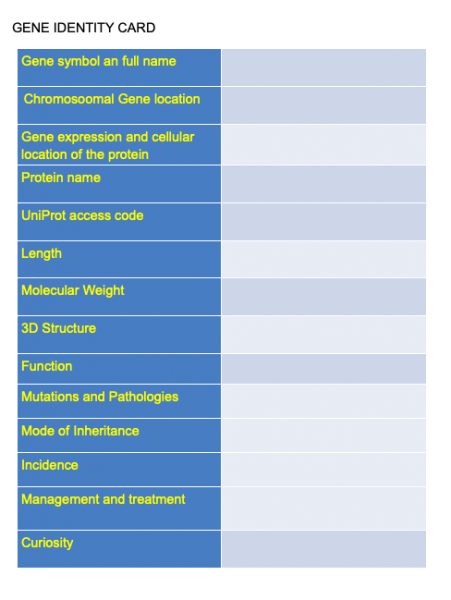
Image courtesy of Cinzia Grazioli
- Explain that genes are named with acronyms, Before selection, it is necessary to find out the meaning of the acronym and determine whether enough is known about the gene, and its role in health and disease, to fill in the card.
- The choice of gene can be guided by the curious name of the gene itself or by the disease associated with malfunction/mutation of the gene. We suggest choosing a gene with an associated phenotype that shows Mendelian inheritance. Many diseases are polygenic, i.e., are caused by the combined effects of more than one gene, as well as by environmental and lifestyle factors, and the contribution of each gene is difficult to assess. Examples include hypertension, coronary heart disease, and diabetes.
- A good way to start is to pick a gene from their own research or the NCBI summary of genes and disease and then look up what chromosome it is on. Older students might like to pick a chromosome first, and then hunt for an interesting gene on it. They can do this by looking at the NCBI detailed genome map. This looks very complicated, since it contains a lot of scientific information. For our purposes, the students just need to click on a chromosome on the far left, and then choose a gene-name acronym from the top row of labelled green bars. They might have to look up several to find one that is interesting to them.
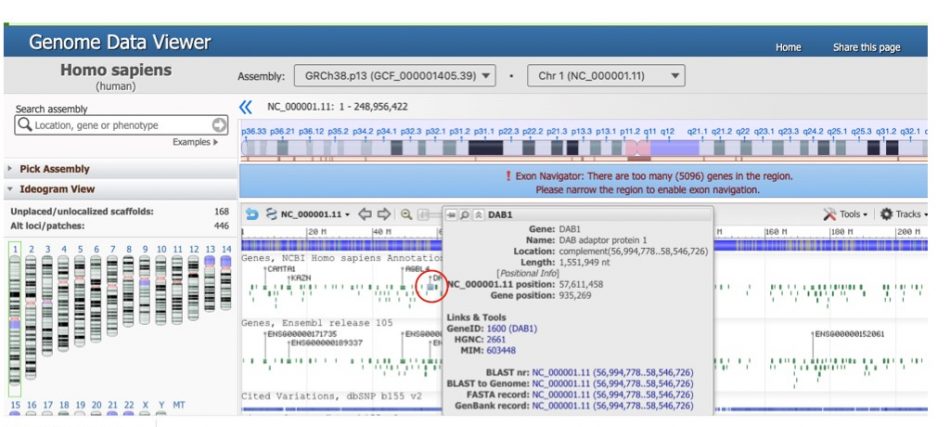
- The following databases[5–9] are recommended for finding relevant information to fill out the card (students might need some guidance from the teacher to help them find the relevant information at first):
- Gene symbol and full name: https://www.genecards.org/, https://www.genenames.org/, https://ghr.nlm.nih.gov/gene
- Chromosomal gene location: https://www.genecards.org/
- Gene expression and protein subcellular localization: https://www.genecards.org/
- Protein name, UniProt access code, length, molecular weight, 3D structure, and function: https://www.uniprot.org/, https://www.rcsb.org/
- Mutations and pathologies (including inheritance, incidence, management, and treatment): https://www.omim.org/, https://www.orpha.net/consor/cgi-bin/index.php
- For the ‘Curiosities’ section: students can do their own internet research, but care is needed to use reliable sources and, especially, to avoid advertisements for pseudoscientific ‘alternative therapies’. Curiosities might include things like mentions in media such as books, movies, and songs; details from particular patient stories; or information from patient associations.
- Gene ID cards must be written in the students’ native language and in English. An example of a complete gene ID card can be found here: http://www.cusmibio.unimi.it/scaricare/walking/fibrosinew.pdf
- Each field must be completed in a concise, but correct way, to be comprehensible and accessible to the general public. It’s very important to enrich text with images and links to external sites and videos, curiosities, and references to real life.
Two points should be made clear to the students:
- The choice of information (correctness and relevance) is crucial to achieve the purpose of disseminating science to the general audience. Don’t get lost and don’t drown in the sea of available information! The effort necessary to develop a gene ID card should not be underestimated. The contents should not be simply ‘copy and paste’ but require nontrivial rereading and rewriting to extract simple information from a complex mass of data.
- Be aware that, to keep the project alive, all the collected data should be updated regularly. Never forget that data science is a world in constant evolution!
Phase 3: Submissions and exhibition
Gene ID cards must be submitted to peer review with the supervision of the science teacher. The card can be sent to CusMiBio by email whenever it is finished; there is no specific submission date. The gene cards will be linked to the chosen chromosome image in the location of the gene by the CusMiBio staff.
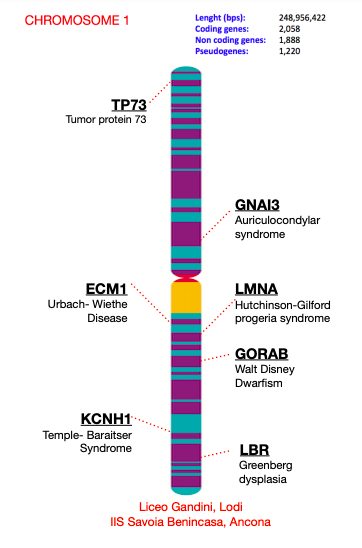
Image courtesy of Cinzia Grazioli
After submission to the CusMiBio Walking on Chromosome project, your ID cards will be reviewed by CusMiBio Staff prior to publication on the chromosome page on the CusMiBio website.
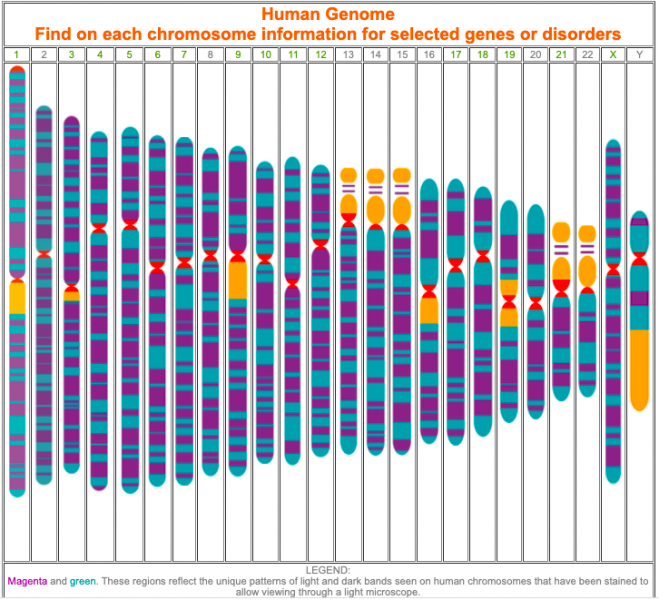
Image courtesy of Cinzia Grazioli
It is then possible to print a poster with the chromosome picture; generate a QR Code (free software, like https://it.qr-code-generator.com, is available); paste it on the poster in the gene location; and, with a simple mobile phone, retrieve information previously loaded in dedicated web space.
These posters can be displayed in school hallways so that students from other classes or parents might participate in a real ‘chromosome walk’ and collect information about our genome on their mobile phones.
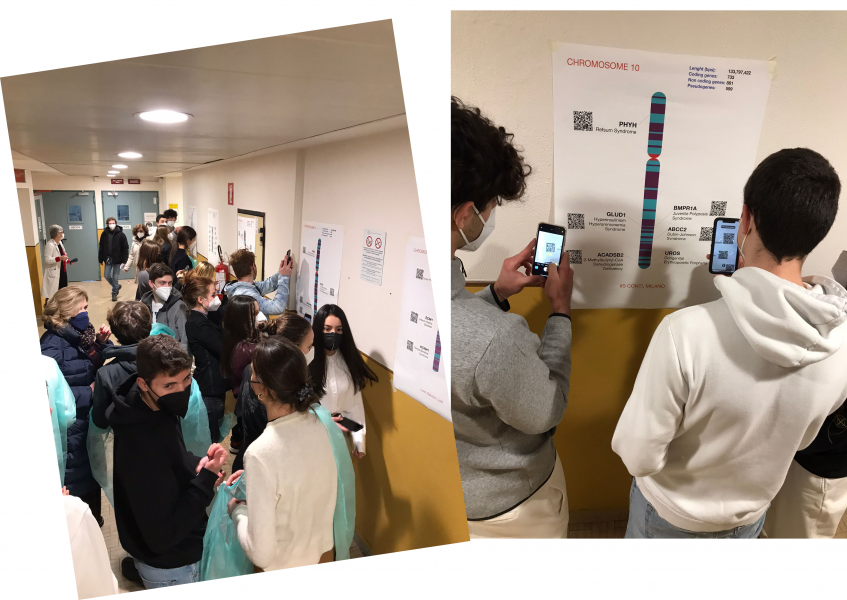
Image courtesy of Cinzia Grazioli
Discussion
There are many ethical and socio-economic implications that can be discussed and dealt with: genetic tests, rights to genetic privacy, pharmacogenomics, and personalised medicine; genetic tests may be beneficial to individuals with specific diseases, but these tests may also provoke fear and worries about what the future may hold. Would you like to know you were prone to an untreatable terminal disease? What about your children? Who should deliver results of genetic tests and to whom? Are genetic tests and genetic privacy regulated by state agencies?
This activity can foster critical thinking and promote deeper discussion of many ethical issues.
References
[1] The human chromosome map on the NCBI website: https://www.ncbi.nlm.nih.gov/books/NBK22266/
[2] The information archive of the Human Genome Project: https://web.ornl.gov/sci/techresources/Human_Genome/posters/chromosome/
[3] The NCBI summary of Genes and Disease: https://www.ncbi.nlm.nih.gov/books/NBK22183/
[4] The NCBI detailed genome map: https://www.ncbi.nlm.nih.gov/genome/gdv/browser/genome/?id=GCF_000001405.39
[5] Databases for gene symbols and full names: https://www.genecards.org/, https://www.genenames.org/, https://ghr.nlm.nih.gov/gene
[6] Database for chromosomal gene location: https://www.genecards.org/
[7] Database for gene expression and protein subcellular localisation: https://www.genecards.org/
[8] Databases for protein name, UniProt access code, length, molecular weight, 3D structure and function: https://www.uniprot.org/, https://www.rcsb.org/
[9] Databases for mutations and pathologies (including inheritance, incidence, management/treatment): https://www.omim.org/, https://www.orpha.net/consor/cgi-bin/index.php
Resources
- Find extensive teaching resources related to genetics on the Genetics Science Learning Centre
- Watch a video introducing the human genome and genomics research.
- Watch a video on rare genetic diseases and what we can learn from them.
- Watch a video about gene therapy and recent success in treating sickle-cell anemia.
- Read an updated patient story related to the above video: Sickle cell: ‘The revolutionary gene-editing treatment that gave me new life’.
- Check out the Gene & Cell Therapy Education resources provided by the American Society of Gene & Cell Therapy.
- Read more about genetic diseases: Patterson L (2009) Getting a grip on genetic diseases. Science in School 13: 53–58.
- Find out more about gene editing technology: Chan H (2016) Faster, cheaper, CRISPR: the new gene technology revolution. Science in School 38: 18–21.
- Teach your students about cancer mutations: Wellcome Trust Sanger Institute Communication and Public Engagement (2010) Can you spot a cancer mutation? Science in School 16: 39–44.





